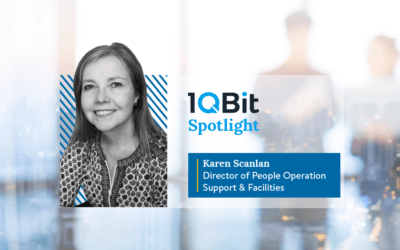Quantum computing research and experimentation continues to make progress towards addressing complex computational problems. These include modelling systems in nature as they relate to chemistry and physics. Beyond this, quantum computing research has also shown promise in tackling problems in logistics and finance.
While these scientific and business fields do not seem related, a natural question does arise: “How could something that is well-suited for, say, modelling some complex molecular system possibly be useful for portfolio building?” The answer to this question is that the solutions to such problems are not all that different when they are viewed from a fundamental perspective.1 The goal of modelling all these systems with advanced and quantum computing methods is the same—to manipulate various parameters to find some optimal combination.

A branch of quantum computing methods known as quantum annealing (QA) has been instrumental in solving such optimization problems.1 New and promising advancements in QA using so-called variational methods not tied to any specific quantum hardware, are highlighted in this article. As QA hardware matures, and devices come to have a larger number of working qubits, these methods will become even more pertinent and impactful. Even now, the new algorithms have shown promising initial results. First, what does the term “variational” mean, and what exactly is QA?
Quantum annealing is a computational procedure for finding the optimized state given many possible solutions by using principles of quantum physics to obtain the minimum energy states of a Hamiltonian–the function that defines the energy of the system. The QA framework dictates that each qubit has a bias (or, strength) and qubits are coupled together. When formulating a QA problem, values are chosen for the biases and couplers, which define an energy landscape, and QA is the process of finding the minimum energy of that specific landscape.
The QA methods highlighted below are adiabatic. Put simply, in quantum mechanics “adiabatic” means that the quantum system can adjust to gradual changes in external conditions. Therefore, a sufficient amount of time—here, referred to as “annealing time”—must be allowed for the external changes to be gradual. Otherwise, the quantum state will not evolve as it should. Yet, having a longer annealing time results in a loss of quantum information due to decoherence of the qubits—their usefulness in preserving information pertaining to a calculation has expired (for more detailed information on quantum hardware and qubits, see the article Building Better Qubits).

The development of algorithms for which the annealing time can be chosen to be small enough to avoid decoherence while also sufficiently long to remain close to a process that is adiabatic is a matter of finding the right balance. Progress has been made to address these issues with variational methods in QA. Why are these methods called “variational”?
A variational method is one in which an educated guess is made in terms of the solution (known as a “trial”) with tunable parameters, which are tweaked until the solution is a good approximation of the exact solution. There is, then, more tunability in the initial guess to allow for a solution that is both more accurate and obtained more quickly.
Highlighted below are two variational QA methods for solving complex computation problems with higher efficiency and resiliency than with standard adiabatic methods. The first is called the Variationally and Adiabatically Navigated Quantum Eigensolver (VanQver),2 and the second is called Variationally Scheduled Quantum Simulation (VSQS).3
The First Approach: VanQver
The crux of the VanQver algorithm is in the choice of the navigator function (i.e., the term “navigated” in the name). The navigator function contains the free parameters that can be tweaked to find the optimal solution. In other words, the navigator is the ingredient that makes it a variational method, allowing the optimization process to more accurately represent the solution compared to standard QA methods. The biggest challenge is, in fact, choosing the best navigator; a poor choice will cause the algorithm not to perform well.
In the case of quantum chemistry, the molecular states are highly structured, which makes it plausible to find good candidates for navigators, which has been investigated in detail.2 In that work, the interdependence of annealing time and chemical accuracy was considered to get a sense of the efficiency of the new method, compared to standard techniques. In fact, the required annealing times for VanQver were found to be significantly lower than those of standard QA by two-to-three orders of magnitude.

The Second Approach: VSQS
In the VSQS algorithm, instead of a navigator function, so-called “schedule functions” make the method variational, and describe how the system evolves in time.
It was found that optimizing the schedule functions shortened the annealing time of a single run significantly.3 The influence of environmental noise and control errors were later studied in the VSQS framework. The results show that while the control errors directly affect the accuracy of the final results, the VSQS algorithm can successfully mitigate their influence and achieve the targeted accuracy. The VSQS method is thus resilient to noise. Further, the VSQS algorithm allows for adjustments to be made to the schedule functions so that the final result more accurately represents the underlying physics. As a proof of concept, the true ground state of a hydrogen molecule was obtained using the VSQS algorithm.
In Summary
Variational algorithms such as VanQver and VSQS are adiabatic QA methods that can have greater noise-resilience and shorter annealing runtimes than other methods. They have shown strong potential to efficiently solve challenging optimization problems in chemistry, physics, economics, and a wide array of other fields involving logistics and networks.

As quantum hardware matures, QA algorithms will likely be used to tackle some of the world’s toughest scientific, technological, and business-oriented problems more rapidly. Already, these algorithms can be run on current, noisy quantum hardware, which is an important step toward further research into developing the fully realized quantum computers of tomorrow.
For more information on quantum-inspired optimization, or to tackle your intractable industrial optimization problems today, please visit our 1Qloud platform.
References
1 E. Grant and T. Humble, “Adiabatic Quantum Computing”, Oxford Research Encyclopedia of Physics, DOI: 10.1093/acrefore/9780190871994.013.32 (2020).
2 S. Matsuura, T. Yamazaki, V. Senicourt, and A. Zaribafiyan, “VanQver: The Variational and Adiabatically Navigated Quantum Eigensolver”, arXiv:1810.11511 (2019).
3 S. Matsuura, S. Buck, V. Senicourt, and A. Zaribafiyan, “Variationally Scheduled Quantum Simulation”, arXiv:2003.09913 (2020).




